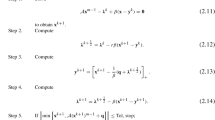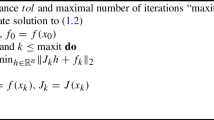Abstract
The matrix equation AXB = E with the constraint PX = sXP is considered, where P is a given Hermitian matrix satisfying P 2 = I and s = ±1. By an eignvalue decomposition of P, the constrained problem can be equivalently transformed to a well-known unconstrained problem of matrix equation whose coefficient matrices contain the corresponding eigenvector, and hence the constrained problem can be solved in terms of the eigenvectors of P. A simple and eigenvector-free formula of the general solutions to the constrained problem by generalized inverses of the coefficient matrices A and B is presented. Moreover, a similar problem of the matrix equation with generalized constraint is discussed.
Similar content being viewed by others
References
Baksalary J K, Kala R. The matrix equation AXB + CYD = E, Linear Algebra Appl, 1980, 30: 141–147.
Chu D, Moor B D. On a varitional formulation of the QSVD and RSVD, Linear Algebra Appl, 2000, 311: 61–78.
Chu K E. Singular value and generalized singular value decompositions and solutions of linear matix equations, Linear Algebra Appl, 1987, 88/89: 83–98.
Chu K E. Symmetric solutions of linear matrix equations by matrix decompositions, Linear Algebra Appl, 1989, 119: 35–50.
Dai H. On the symmetric solutions of linear matrix equations, Linear Algebra Appl, 1990, 131: 1–7.
Deng Y B, Hu X Y, Zhang L. Least squares solutions of BXA T = T over symmetric, skewsymmetric, and positive semidefinite X*, SIAM J Matrix Anal Appl, 2003, 25: 486–494.
Liao A P, Bai Z Z, Lei Y. Best approximate solution of matrix equation AXB + CY D = E, SIAM J Matrix Anal Appl, 2005, 27: 675–688.
Moor B D, Golub G H. Generalized singular value decompositions:a proposal for a standardized nomenclature, Zaterual Report, 89-10, ESAT-SISTA, Leuven, Belgium, 1989.
Özgüler A B. The equation AXB + CYD = E over a principle ideal domain, SIAM J Matrix Anal Appl, 1991, 12: 581–591.
Paige C C, Saunders M A. Towards a generalized singular value decomposition, SIAM J Numer Anal, 1981, 18: 398–405.
Paige C C. Computing the generalized singular value decomposition, SIAM J Sci Comput, 1986, 7: 1126–1146.
Xu G P, Wei M S, Zheng D S. On solutions of matrix equation AXB + CYD = F, Linear Algebra Appl, 1998, 279: 93–109.
Author information
Authors and Affiliations
Additional information
The work of the first author was supported by the Young Talent Foundation of Zhejiang Gongshang University.
Rights and permissions
About this article
Cite this article
Qiu, Y., Qiu, C. Matrix equation AXB = E with PX = sXP constraint. Appl. Math.- J. Chin. Univ. 22, 441–448 (2007). https://doi.org/10.1007/s11766-007-0409-9
Received:
Issue Date:
DOI: https://doi.org/10.1007/s11766-007-0409-9




